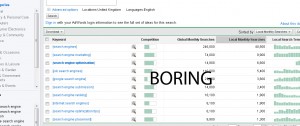If you are serious about ranking high within the search engine result pages and are serious about SEO then you will know that obtaining high authority, quality links from related website is one of the main factors in increasing ranking position.
Links can be achieved through a number of methods. Sourcing high authority blogs with link bait ideas, paid directories (yahoo directory) which offer instant boosts for a fee or article marketing and free directory submissions.
Working within a success SEO company, we are constantly challenge by our clients to ‘beat’ the competition. I am sure the competition are saying the same thing! Regardless, one of the main principles of SEO is ranking high within the serp’s for the keywords chosen by the clients. Achieving this requires back links and where better to start than analysing the back links of your nearest and dearest competitors? Gaining the knowledge of how your competitors rank high for a competitive keyword is a crucial aspect of successful SEO. Once you understand these links you are able to emulate their most valuable links aligned with your own strategy to move ahead in the search result pages.
There are many tools which you can use to analyse competitor back links. The SEO moz open site explorer is a fantastic tool for link popularity and backlink analysis. Alternatively you can explore competitor back links through Yahoo site explorer. Principally these tools are great in sourcing competitor back links but a personal favourite of mine is SEO Spyglass produced by Link Assistant.


